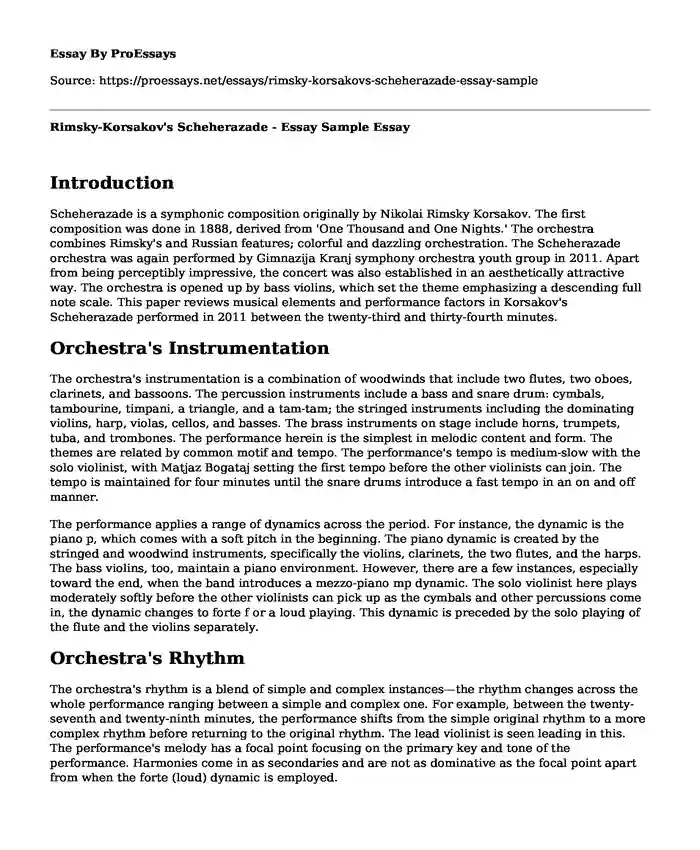Introduction
Scheherazade is a symphonic composition originally by Nikolai Rimsky Korsakov. The first composition was done in 1888, derived from 'One Thousand and One Nights.' The orchestra combines Rimsky's and Russian features; colorful and dazzling orchestration. The Scheherazade orchestra was again performed by Gimnazija Kranj symphony orchestra youth group in 2011. Apart from being perceptibly impressive, the concert was also established in an aesthetically attractive way. The orchestra is opened up by bass violins, which set the theme emphasizing a descending full note scale. This paper reviews musical elements and performance factors in Korsakov's Scheherazade performed in 2011 between the twenty-third and thirty-fourth minutes.
Orchestra's Instrumentation
The orchestra's instrumentation is a combination of woodwinds that include two flutes, two oboes, clarinets, and bassoons. The percussion instruments include a bass and snare drum: cymbals, tambourine, timpani, a triangle, and a tam-tam; the stringed instruments including the dominating violins, harp, violas, cellos, and basses. The brass instruments on stage include horns, trumpets, tuba, and trombones. The performance herein is the simplest in melodic content and form. The themes are related by common motif and tempo. The performance's tempo is medium-slow with the solo violinist, with Matjaz Bogataj setting the first tempo before the other violinists can join. The tempo is maintained for four minutes until the snare drums introduce a fast tempo in an on and off manner.
The performance applies a range of dynamics across the period. For instance, the dynamic is the piano p, which comes with a soft pitch in the beginning. The piano dynamic is created by the stringed and woodwind instruments, specifically the violins, clarinets, the two flutes, and the harps. The bass violins, too, maintain a piano environment. However, there are a few instances, especially toward the end, when the band introduces a mezzo-piano mp dynamic. The solo violinist here plays moderately softly before the other violinists can pick up as the cymbals and other percussions come in, the dynamic changes to forte f or a loud playing. This dynamic is preceded by the solo playing of the flute and the violins separately.
Orchestra's Rhythm
The orchestra's rhythm is a blend of simple and complex instances—the rhythm changes across the whole performance ranging between a simple and complex one. For example, between the twenty-seventh and twenty-ninth minutes, the performance shifts from the simple original rhythm to a more complex rhythm before returning to the original rhythm. The lead violinist is seen leading in this. The performance's melody has a focal point focusing on the primary key and tone of the performance. Harmonies come in as secondaries and are not as dominative as the focal point apart from when the forte (loud) dynamic is employed.
Harmony is also present in the ensemble. The harmony is composed of consonant chords with different players playing notes that fit with the same chord. Other instruments across the performance play the melody. At some point, the violin carries the melody, while the flute takes the melody. However, as the melody is played by one group of instruments, the others play harmony. The bass is in this performance always in harmony. The orchestra was first played during the romantic era between 1815 and 1910 when composed by Rimsky-Korsakov.
Conclusion
Thus, because of the orchestra's era setting, the performance expresses different moods through different dynamics employed, as discussed above. The tempo ranges differently along with different dynamics, a character of the romantic era. Combined with a touch of electronic manipulation, especially the violins, the performance becomes even exciting.
References
Zevnikov. (2011, January 7). Rimsky-Korsakov: Scheherazade - op.35 - Simply Stunning Performance. [Video]. YouTube.
https://www.youtube.com/watch?v=17lEx0ytE_0.
Cite this page
Rimsky-Korsakov's Scheherazade - Essay Sample. (2024, Jan 10). Retrieved from https://proessays.net/essays/rimsky-korsakovs-scheherazade-essay-sample
If you are the original author of this essay and no longer wish to have it published on the ProEssays website, please click below to request its removal:
- Identifying the Guidelines Used in Writing a Book Review
- Analysis of the Film Fences
- Essay Example on Religious Symbolism: Jesus in the Last Supper Murals
- Essay Sample on Social Media Usage: Four Billion Users Globally and 70% in US
- Essay Example on Turning the Tables: Preserving History Through NPR Music's Series
- The Searchers - Movie Analysis Essay
- Essay Example on Global Fashion Industry







